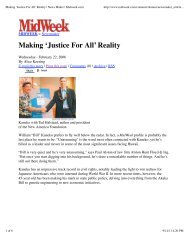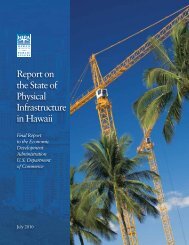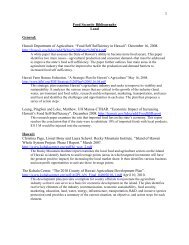Hawai'i Fisheries Initiative - The Hawaii Institute for Public Affairs
Hawai'i Fisheries Initiative - The Hawaii Institute for Public Affairs
Hawai'i Fisheries Initiative - The Hawaii Institute for Public Affairs
Create successful ePaper yourself
Turn your PDF publications into a flip-book with our unique Google optimized e-Paper software.
National and<br />
Statewide<br />
Economic Impact<br />
of <strong>Fisheries</strong><br />
“<strong>The</strong> significance of our marine fishery<br />
resources is clear,” said U.S. Department<br />
of Commerce Secretary Carlos Gutierrez in<br />
March 2007. “It’s a $65 billion industry and<br />
a mainstay <strong>for</strong> countless communities along<br />
the nation’s 12,000 miles of coastline. As<br />
the industry grows it’s expected to create<br />
some 25,000 new jobs and support another<br />
75,000 in other industries.” 25<br />
More than $1 trillion – one-tenth of the<br />
nation’s annual gross domestic product –<br />
is generated near the nation’s coastline, and<br />
that number becomes more than half of the<br />
GDP when taking into account all coastal<br />
watershed counties, according to the<br />
Joint Oceans Commission’s 2006 report to<br />
Congress. In 2003, ocean-related economic<br />
activities contributed more than $119 billion<br />
to the American economy and supported<br />
more than 2.2 million jobs, with roughly<br />
three-quarters of those totals produced by<br />
ocean-related tourism and recreation. 26<br />
Primary Issues<br />
Facing U.S.<br />
<strong>Fisheries</strong> (2007)<br />
Secretary of Commerce Carlos Gutierrez<br />
identified the following as key national issues<br />
related to wild and aquaculture fisheries,<br />
import/exports, and seafood demand 27 :<br />
n <strong>The</strong> United Nations projects a 40 million ton<br />
global seafood shortage by 2030.<br />
n Even with the best-managed fisheries, the U.S.<br />
will not be able to satisfy consumer demand.<br />
Aquaculture is the means of narrowing the<br />
trade gap and meeting consumer demand.<br />
n Aquaculture can be used to decrease U.S.<br />
seafood trade deficit ($8 billion in 2005) and<br />
increase market share.<br />
n <strong>The</strong> U.S. accounts <strong>for</strong> 1.5 percent of global<br />
aquaculture (China generates 70 percent; the<br />
remainder of Asia, 20 percent).<br />
n Hawai‘i has 100 aquaculture farms; it is<br />
considered a leader in the industry, but<br />
$40 million (2006) is a fraction of what Hawai‘i<br />
is capable of producing.<br />
n <strong>The</strong>re is a labor shortage in harvesting<br />
and processing of seafood; <strong>for</strong>eign labor is<br />
necessary. <strong>The</strong> Hawai‘i Longline Association<br />
<strong>for</strong>med a Foreign Crew Task Force in early<br />
2007 to work with the U.S. Border Protection<br />
Agency regarding <strong>for</strong>eign crew visa, bonding,<br />
and dock-side and dry-dock policies. 28<br />
n <strong>The</strong> reauthorized Magnuson-Stevens Act<br />
requires an end to overfishing by 2011.<br />
n Rebuild fish stocks through effective,<br />
market-based management.<br />
n Aggressively en<strong>for</strong>ce annual catch limits.<br />
n Promote sustainable use of ocean resources.<br />
10







